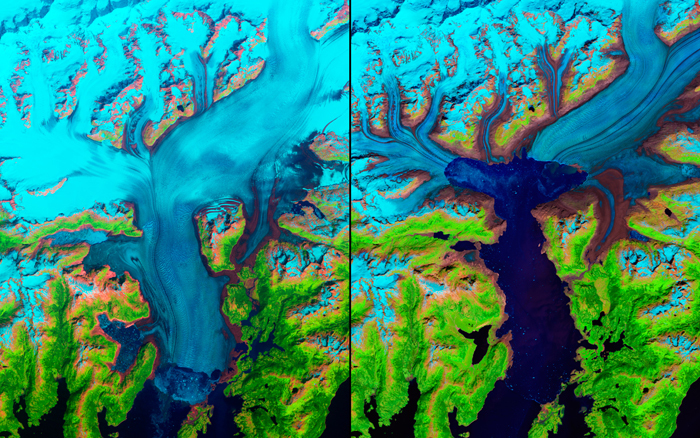Slowing global warming is like turning an oil tanker
25 February 2015
The Japanese Meteorological Society measured 2014 as the hottest year on record – this while the Earth is meant to be in a cooling stage. With the help of a number of UCT researchers, Monday Monthly delves deeper into the science of climate change, global warming, and their effects on earthlings. We start with Professor Mark New, director of UCT's African Climate and Development Initiative, who explains that there is already significant research money going into potential solutions to climate change. In fact, many of the solutions already exist. The challenge is getting economies, governments, and companies to adopt them.
What's the difference between climate and weather?
To quote Ed Lorenz, the discoverer of Chaos Theory: climate is what you expect, weather is what you get. What this means is that when we talk about climate, we are describing the general characteristics of the atmosphere at a particular location. So for example, we might say the climate of Cape Town in February is an average daily temperature of 25 degrees, ranging between 10 and 40 degrees. On any particular February day, the temperature might be any value between 10 and 40 degrees – that's the weather, what we experience in any single day, hour, minute, second. When we measure the weather over a long period of time, all the measurements add up to tell us about the climate.
Is it true that we are meant to be in a period of global cooling, yet 2014 was the hottest year on record?
On timescales of thousands of years, in which the orbit of the earth varies with respect to the sun, and changes the intensity and latitudinal impact of solar radiation that affects the temperature of the earth, we have been moving slowly into a period with less warming from the sun, but only by small amounts. If the past cycles of ice ages are repeated, we are due, sometime in the next ten thousand years, to gradually enter the next great ice age. 2014 was the hottest year on record in the last 150 years, for which we have enough temperature measurements around the world to get a reasonably reliable estimate of global mean temperature.
So 2014 was hot in the context of the last 150 years; and indeed, the last 10-15 years contain most of the hottest years on record, so we are seeing an unusual clustering of hot years. If the climate was just varying naturally, we'd expect extremely hot years to be roughly evenly distributed over the last 150 years. There is really strong evidence – 99% confidence – that the warming we are seeing is due to human greenhouse gas and related emissions. So human activity is potentially offsetting a gradual cooling, but it's doing more than that; it's pushing the balance way further in the other direction, making the earth warmer than at any time in modern human history.
 Two images of Mount Kilimanjaro produced by placing satellite over digital elevation models. Images are dated February 17, 1993 (left) and February 21, 2000 (right).
Two images of Mount Kilimanjaro produced by placing satellite over digital elevation models. Images are dated February 17, 1993 (left) and February 21, 2000 (right).
Some scientists predict that humanity's very existence may come under serious threat in just a few decades if global warming is not tackled post-haste; is the problem really this urgent?
Whether humanity's existence is at threat from climate change is debatable. That climate change poses an additional threat to many humans is clearly shown in many studies, and in some of the impacts we have already seen. In a growing number of examples of humanitarian disaster – floods, droughts, massive wildfires – scientists have shown that global warming has increased the likelihood of such events occurring.
And every year that greenhouse gas emissions rise means an increase in the speed of global warming, and an increase in the risk of climate-related disasters. And most greenhouse gases hang around in the atmosphere for many decades, so CO2 emitted today has an effect into at least the second half of the next century. Slowing and reversing global warming is like turning a large oil tanker – you need to start turning the wheel long in advance of where you need to turn because of momentum in the system.What would your ideal scenario be for the next twenty years if we are to reverse or at least slow down the trend of global warming?
Ideally, no new carbon-based energy development, and a rapid – relatively speaking, say over 20 years – shut-down of existing carbon energy to be replaced by alternatives, so that by the 2040s, the world's energy system is largely carbon-free. This should be coupled with massive improvements in energy efficiency, which has the dual benefit of reducing what we spend on energy, and making it easier to transition to a new energy system.
Realistically, if the rate of warming is slowing down by 2035, that will be a miracle. I don't have much faith in the altruism of the 1% of the people in the world who own 50% of the wealth, or in the ability of economies and governments to undergo the types of transformation that are needed. But we have to keep trying and pushing, for the sake of our children, and their children.
Story by Yusuf Omar. Images courtesy of NASA.
 This work is licensed under a Creative Commons Attribution-NoDerivatives 4.0 International License.
This work is licensed under a Creative Commons Attribution-NoDerivatives 4.0 International License.
Please view the republishing articles page for more information.










